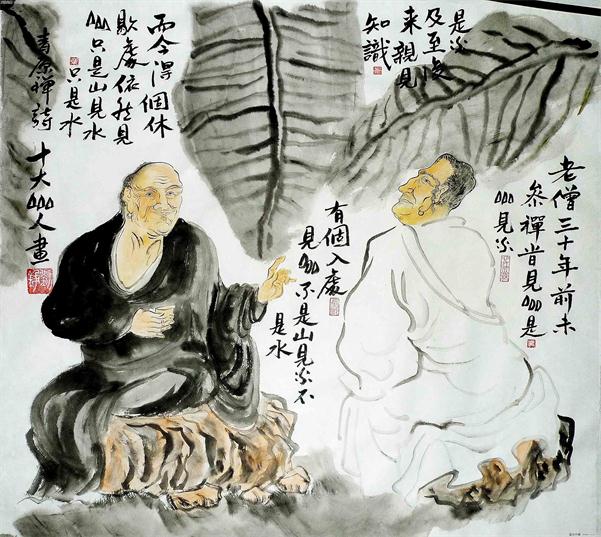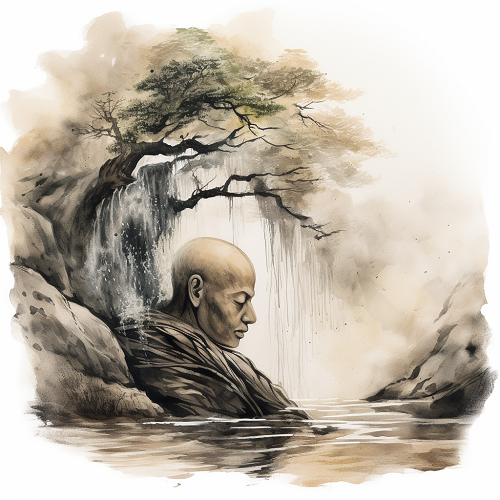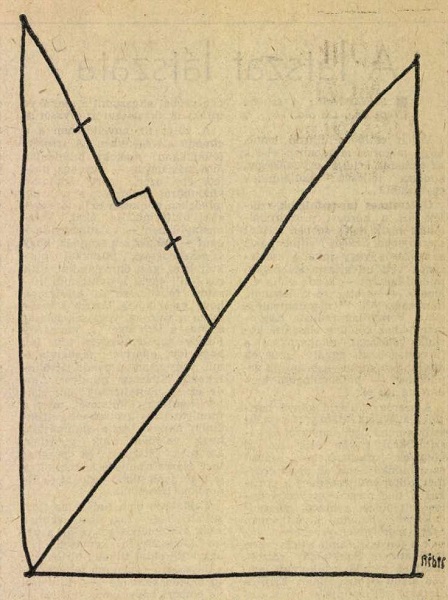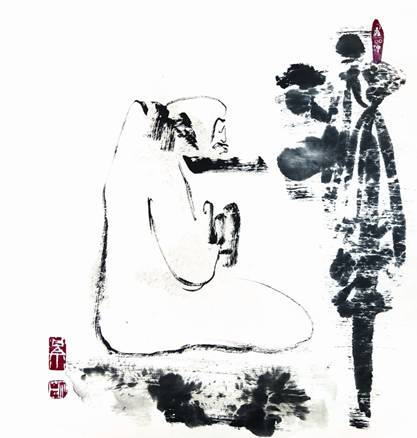ZEN IRODALOM ZEN LITERATURE
« Zen főoldal
« vissza a Terebess Online nyitólapjára

青原惟信 Qingyuan Weixin (9th cent.)
(Rōmaji:) Seigen Ishin
Tartalom |
Contents |
| Csing-jüan Vej-hszin mondásaiból Fordította: Terebess Gábor |
English versions, 1926-2012 |

AI-generated image by Pál Terebess (2023)
Qingyuan declared that there were three stages in his understanding of the dharma: the first stage, seeing mountain as mountain and water as water; the second stage, seeing mountain not as mountain and water not as water; and the third stage, seeing mountain still as mountain and water still as water.
(Xu Chuandenglu 續傳燈錄, T no.2077, 51:614b-c.)
D.T. Suzuki (1926)
According to Seigen Ishin (Ch'ing-yüan Wei-hsin):
"Before a man studies Zen, to him mountains are mountains and waters are waters; after he gets an insight into the truth of Zen through the instruction of a good master, mountains to him are not mountains and waters are not waters; but after this when he really attains to the abode of rest, mountains are once more mountains and waters are waters."
(D. T. Suzuki, Essays in Zen Buddhism, First Series, 1926, London; New York: Published for the Buddhist Society, London by Rider, p. 24.)
Alan Watts (1951)
The famous saying of Ch'ing-yüan Wei-hsin [Seigen Ishin]
Before I had studied Zen for thirty years, I saw mountains as mountains, and waters as waters. When I arrived at a more intimate knowledge, I came to the point where I saw that mountains are not mountains, and waters are not waters. But now that I have got its very substance I am at rest. For it's just that I see mountains once again as mountains, and waters once again as waters. [13]
[13] Ch'uan Teng Lu, 22.
老僧三十年前未參 禪時、見山是山、見水是水、及至後 夾 親見知識、有箇入處、見山不是山、見水不是水、而今得箇體歇處、依然見山 秪 是 山、見水 秪 是水(Alan Watts, The Way of Zen, New York, Pantheon Books, 1951, p. 126, 220 k)

Donovan Leitch (1967)
The 1967 psychedelic rock song of Donovan Leitch, “There Is a Mountain,” with the lyrics, ”First there is a mountain, then there is no mountain, then there is.” https://www.youtube.com/watch?v=XcMM5-zBCEc
There Is a Mountain
Song LyricsThe lock upon my garden gate`s a snail, that`s what it is.
The lock upon my garden gate`s a snail, that`s what it is.
First there is a mountain, then there is no mountain, then there is.
First there is a mountain, then there is no mountain, then there is.
The caterpillar sheds his skin to find a butterfly within.
Caterpillar sheds his skin to find a butterfly within.
First there is a mountain, then there is no mountain, then there is.
First there is a mountain, then there is no mountain.
Oh Juanita, oh Juanita, oh Juanita, I call your name.
Oh, the snow will be a blinding sight to see as it lies on yonder hillside.
The lock upon my garden gate`s a snail, that`s what it is.
The lock upon my garden gate`s a snail, that`s what it is.
Caterpillar sheds his skin to find a butterfly within.
Caterpillar sheds his skin to find a butterfly within.
Ah, my-my.
First there is a mountain, then there is no mountain, then there is.
First there is a mountain, then there is no mountain, then there is.
First there is a mountain, then there is no mountain, then there is.
First there is a mountain, then there is no mountain, then there is.
First there is a mountain

Van hegy
Kertkapum retesze csiga bizony.*
Kertkapum retesze csiga bizony.
Először van hegy, aztán nincs hegy, aztán van.
Először van hegy, aztán nincs hegy, aztán van.
A hernyó vedlett bőrében pillangó.
Hernyó vedlett bőrében pillangó.
Először van hegy, aztán nincs hegy, aztán van.
Először van hegy, aztán nincs hegy.
Ó Juanita, Ó Juanita, Ó Juanita, egyre hívlak.
Ó, vakító hótakaró távolban a domboldalon.
Kertkapum retesze csiga bizony.
Kertkapum retesze csiga bizony.
Hernyó vedlett bőrében pillangó.
Hernyó vedlett bőrében pillangó.
Ah, az én, az én
Először van hegy, aztán nincs hegy, aztán van.
Először van hegy, aztán nincs hegy, aztán van.
Először van hegy, aztán nincs hegy, aztán van.
Először van hegy, aztán nincs hegy, aztán van.
Először van hegy*Vö. 小林一茶 (Kobayashi Issa, 1763-1828) haikujával:
柴門や錠のかはりのかたつぶり
shiba no to ya jō no kawari no katatsuburi (1815)sövénykapumra
került végre retesz is
egy kerti csiga(Terebess Gábor fordítása)
Fritjof Capra (1975)
To regain the naturalness of our original nature requires long training and constitutes a great spiritual achievement. In the words of a famous Zen saying,
Before you study Zen,
mountains are mountains and rivers are rivers;
while you are studying Zen,
mountains are no longer mountains and rivers are no longer rivers;
but once you have had enlightenment
mountains are once again mountains and rivers again rivers.(The Tao of Physics by Fritjof Capra, first published in 1975, London: Wildwood House, New York: Bantam Books, p. 126)
Abe Masao 阿部正雄 (1983)
Thirty years ago, before I began the study of Zen, I said, "Mountains are mountains, waters are waters." After I got an insight into the truth of Zen through the instruction of a good master, I said, "Mountains are not mountains, waters are not waters." But now, having attained the abode of final rest [i.e., Awakening], I say, "Mountains are really mountains, waters are really waters."
(Ch'ing-yuan Wei-hsin. Quoted by Masao Abe: "God, Emptiness, and Ethics"; Buddhist-Christian Studies, Vol. 3. (1983), pp. 53-60. [p.56])
The following discourse given by the Chinese Zen master Ch'ing-yuan Wei-hsin (Ja: Seigen Ishin) of the T'ang dynasty provides a key by which we may approach Zen philosophy. His discourse reads as follows:Thirty years ago, before I began the study of Zen, I said, 'Mountains are mountains, waters are waters.' After I got an insight into the truth of Zen through the instruction of a good master, I said, 'Mountains are not mountains, waters are not waters.' But after having attained the abode of final rest [that is, Awakening], I say, 'Mountains are really mountains, waters are really waters.'
And then he asks, 'Do you think these three understandings are the same or different?(Abe Masao. Zen and Western Thought. Edited by William R. LaFleur. Honolulu: University of Hawaii Press, 1985, p. 4.)
Urs App (1994)
The passage in question is from the Compendium of the Five Lamps (Wudeng huiyuan), in the Zokuzoukyou, 138: 335a line 9 ff. Master Qingyuan made the statement. A translation, in Urs App's _Master Yunmen_, pp. 111-12, note 2 reads:
"Thirty years ago, before I practiced Chan, I saw that mountains are mountains and rivers are rivers. However, after having achieved intimate knowledge and having gotten a way in, I saw that mountains are not mountains and rivers are not rivers. But now that I have found rest, as before I see mountains as mountains and rivers as rivers."
PDF: Master Yunmen : from the record of the Chan Master "Gate of the Clouds"
translated, edited, and with an introduction by Urs App, New York : Kodansha International, 1994. 252 p.
Nonin Chowaney (2012)
Rev. Nonin Chowaney
Soto Zen Buddhist Priest. Transmitted Dharma Heir of Dainin Katagiri Roshi.
Abbot and Head Teacher, Nebraska Zen Center / Heartland Temple, Omaha, Nebraska, USA
http://www.zenforuminternational.org/viewtopic.php?f=17&t=8382First seeing mountains as mountains and rivers as rivers means seeing them as fixed and solid entities in and of themselves.
Later seeing them as not mountains and not rivers means we understand that neither mountains nor rivers exist in and of themselves, that they are empty of inherent existence and made up of other beings that are also empty of inherent existence. For instance, there is nothing within a mountain that we can pull out and say, "this is mountain," or, "this is what makes a mountain a mountain." Mountains are made up of rocks, trees, grass, snow, water, rivers, ponds, lakes, insects, birds, animals, etc., etc., etc., and all of these things are made up of other things. So, there are no mountains and no rivers.
When we continue to practice, and our wisdom eye is fully opened, we realize that mountains are indeed mountains, and rivers are indeed rivers, for there is a mountain there and a river over here. However, we deeply understand that both "mountain" and "river" are merely words that we use to describe the conditioned phenomena in front of us. Neither phenomena is a fixed nor permanent entity that exists in and of itself and possesses inherent existence as "mountain," or "river." In other words we experience and understand their true nature, and the true nature of all beings.
Csing-jüan Vej-hszin mondásaiból
Fordította: Terebess Gábor
Folyik a híd, Officina Nova, Budapest, 1990, 79. oldal
Csing-jüan mondta:
– Harminc éven át tanulmányoztam a csant. Eleinte a hegyek hegyek voltak, a vizek vizek. Ahogy jobban elmélyültem, a hegyek megszűntek hegyek, a vizek megszűntek vizek lenni. De most, hogy a végére jutottam, a hegyek újra hegyek, a vizek újra vizek.

Réber László rajza (Élet és Irodalom, 1984. január 13., 9. oldal)D.T. Suzuki-anekdota John Cage: A csend c. könyvéből (Erős László Antal fordítása):
„A zen tanulmányozása előtt az emberek emberek, a hegyek pedig hegyek. A zen tanulmányozása közben a dolgok összezavarodnak. A zen tanulmányozása után az emberek emberek, a hegyek pedig hegyek. Miután ezt elmondta, dr. Suzukinak feltették a kérdést: - Mi a különbség az előtte és az utána között? - Nincs semmi különbség, csak a lábak kissé elemelkednek a földtől.”

甘泉 Gan Quan illusztrációja (2013)
.